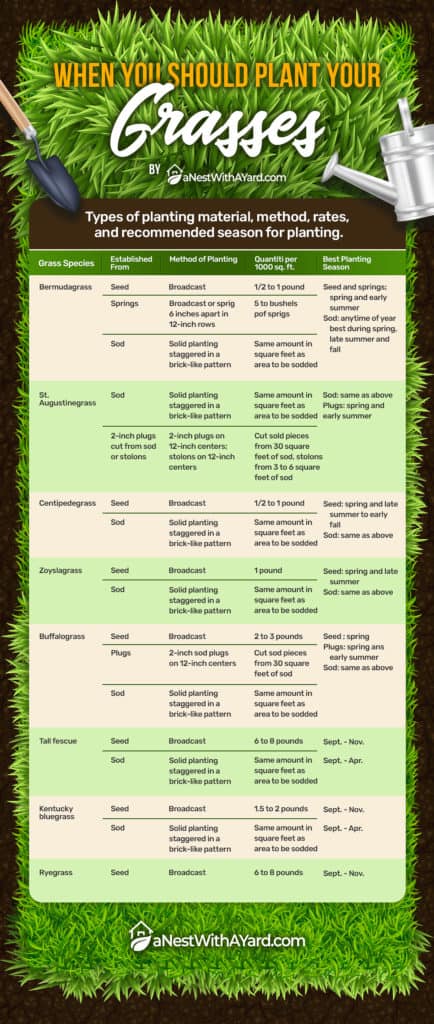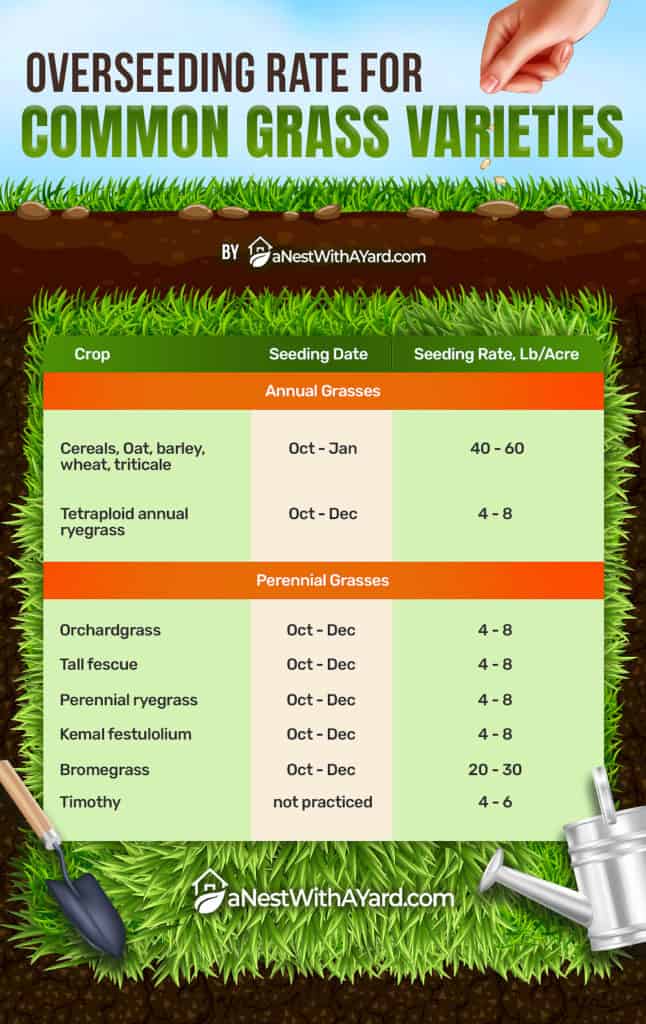If you want to overseed your lawn without aerating, you must mow the existing lawn and loosen the soil with a rake or dethatcher. Next, add the new seeds and use your rake to spread them evenly. Lastly, you should fertilize and water the seeds to help them establish.
Is your turf looking a little worse for wear? If so, you may be looking for how to overseed lawn without aerating. This process can rejuvenate your grass, fill in any gaps, and make it more healthy overall.
Because you skip the aerating step, it is a lot less labor-intensive and can still yield excellent results. Read on to discover why and when you should overseed your lawn and how you can do it without aerating.
Contents
Do You Need To Aerate Before Overseeding Lawn?
Aerating your lawn means poking holes in its surface to allow air to circulate more freely. It can also allow water and nutrients to reach your turf’s roots more effectively by loosening the soil. Therefore, it helps your lawn seeds germinate and grow.
Aeration is essential for your lawn health, but it is labor-intensive. It can also be expensive, especially if you need to buy or rent an aerator. It is not essential for overseeding, so you can use different methods to achieve a thicker turf.
Why Should You Overseed Your Lawn?
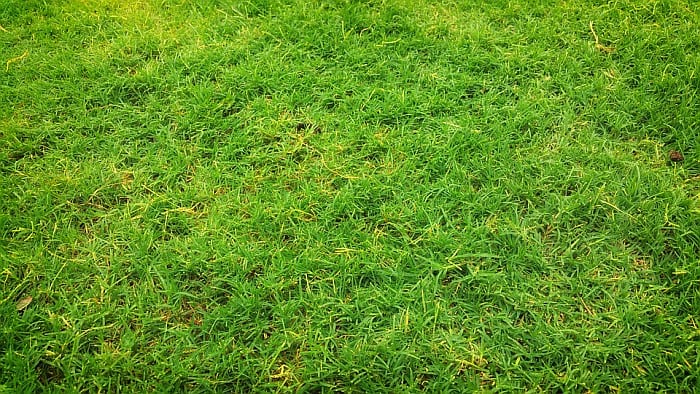
Overseeding means planting new lawn seeds on top of your existing turf. You do not remove the previous grass or turn the soil during this process. This method can fill in any gaps in your lawn, improving its aesthetic appearance and health.
You may need to overseed your lawn if you are the new tenant or owner of a property. If the previous family did not take good care of their turf, it might have unsightly holes or thin patches across its surface.
Overseeding can also help you transition from one type of lawn to another.
If the previous owners did not care for the existing turf or grew it in poor conditions, the grass may be vulnerable to disease and pests. You can use overseeding to start shifting to a hardier lawn variety, like Zoysia or Buffalo.
When Should You Overseed Your Lawn?
The best time for overseeding your lawn depends on whether you want to plant warm-season grasses or cool-season grasses. It also depends on your location and climate.
As a general rule, you should overseed warm-season grasses at the end of spring and cool-season grasses at the start of fall. By doing so, you allow the seeds to thrive during their optimal growth conditions.
However, you can theoretically overseed in any season, but when you do it can affect the growth of your new turf.
Overseeding in spring in some climates can be risky because of rainfall. This season allows the growth of weeds, which can compete with your seeds for water and nutrients. There may also be hot days that could dry out the plants.
Summer is also not the best time for you to overseed your lawn. The harsh sunlight and lower water levels can stress your plants and make it harder for the turf to grow. Many plant diseases are also more prevalent during summer.
Lastly, winter can be a challenging time to overseed. If you live in a cooler climate, snow and frost can make it difficult (or impossible) for grass to grow. Many plants are also dormant during this season.
You should pay attention to which grasses grow best in which temperature conditions.
These are the most common types of warm-season grasses:
- Buffalo
- Carpet
- Zoysia
- St. Augustine
- Bahia
- Bermuda
- Centipede
These are the most common varieties of cool-season grasses:
- Ryegrass
- Bluegrass
- Tall fescue
- Creeping bent
- Creeping red fescue
The table below shows some of the most common varieties of grasses and when you should plant them. You can follow the “seed” recommendations if you want to use the overseeding method (click on the image to enlarge).
How To Overseed Lawn Without Aerating – 5 Steps
Mow Your Lawn
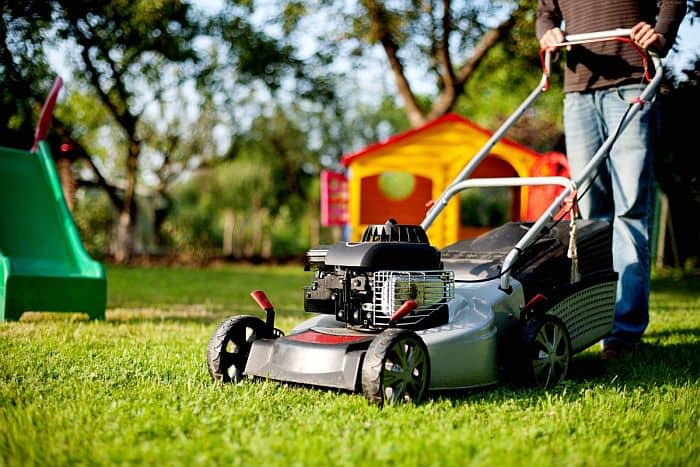
Grab your lawnmower and mow your existing lawn. You want to cut it so that it is around 1 to 2 inches high.
It is vital to cut your lawn short because it will stop weeds and the existing turf from fighting with the new seeds for nutrients and water. It also allows sunlight to penetrate the surface, reach the soil, and help the seeds grow. Lastly, it will enable the seeds to reach the ground and not stick in the existing grass.
Make sure that you have a grass bag attached to your lawnmower during this process. Mulching the lawn and allowing it to sit on the surface is counterintuitive because it will stop the seeds from reaching the earth.
If you’d like to see more tips for mowing your lawn, you can check out this video.
Loosen The Soil
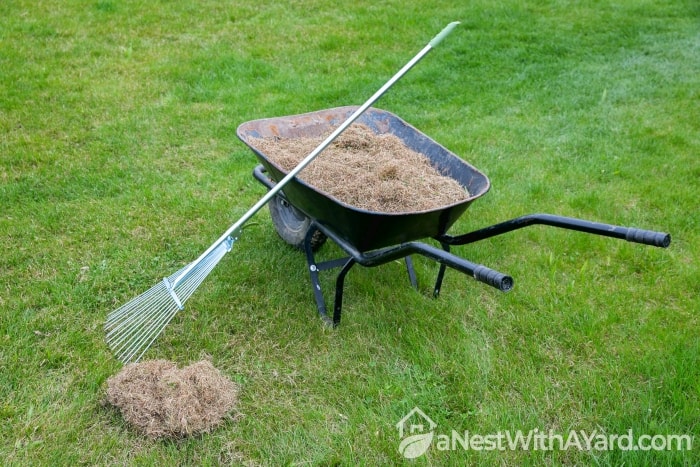
Because you are not aerating, you will need to loosen up the soil with a metal thatching rake or dethatcher. Grab your rake and drag it across the surface of the earth. You want to do this firmly enough to remove the thatch, which is the dead plants, grass clippings, and any other debris.
Check out this video for the best technique to use with your rake.
This step is essential for your new grass seeds to grow. The loose soil lets your seeds germinate and access the water and nutrients they need.
Be aware that this raking can damage your existing lawn. Therefore, I recommend doing it early in the season, so your turf can grow back, along with the new grass.
Spread The Seeds
I recommend using a drop spreader for this step. It allows you to spread the seeds evenly across the exposed earth. You may like to apply the seed in both directions so you get the most even coverage.
If you don’t have access to a drop spreader, you can do it by hand. In this case, you will need to mix the seeds with sand. However, I don’t recommend this method except as a last resort because you can get uneven coverage.
Furthermore, make sure that you don’t have sand sitting on top of the seeds. It can bury them and prevent them from germinating properly.
Different grass varieties need different rates for overseeding. This means the number of seeds that you should have in a set amount of space. If you buy your seeds from a packet, it should say the recommended rate for that type.
The table below shows the recommended rate for a few different grass varieties.
Rake The Seeds
Use your rake again, but this time gently. This step allows the seeds to settle into the soil, stopping birds from eating them or water from washing them away.
However, be cautious that you do not rake too hard. You risk moving the seeds around, which could create gaps or too many in one place. You may like to rake in all directions to avoid this complication.
Fertilize And Water

Cover the area with your starter fertilizer. I recommend using 10-10-10 fertilizer because it has a good balance of phosphorus, nitrogen, and potassium. Phosphorus is particularly important because it helps roots grow.
Check the instructions on your fertilizer for how much you should use. As a general rule, you will need to use 1-2 pounds of fertilizer per 1000 square feet of lawn. However, it may depend on your turf and fertilizer varieties.
Use your garden hose or watering can and lightly water the lawn. You should repeat this process twice a day for three weeks while the new seeds establish themselves. After that point, you can water more heavily if needed.
You will need to wait some time before mowing your new grass after overseeding. Check out my guide here, so you can get it perfectly right.
FAQs
Can You Overseed Without Aerating?
You can overseed lawn without aerating to improve your turf. Use a combination of a lawnmower and a rake or dethatcher to loosen the soil before spreading your seeds and fertilizer across the ground. Water the area, mow as needed, and apply more fertilizer after six weeks.
Can I Just Sprinkle Grass Seed On My Lawn?
You can sprinkle grass seed on your lawn, but it can cause problems. By not correctly overseeding, you risk the seeds not establishing roots and reducing the quality of your existing turf over time. This can even kill it entirely in the long term.
How To Overseed Lawn Without Aerating: A Summary
In summary, this guide shows you how to overseed lawn without aerating. By following these steps, you can fill in patchy turf and increase its health:
- Mow the existing turf.
- Loosen the soil with a rake or dethatcher.
- Spread the seeds with a drop spreader and rake them.
- Fertilize with starter fertilizer and water lightly and frequently.
Overseeding your lawn can transform your backyard into a beautiful space, as long as you take the time to do it properly. Please comment if you have any further questions or tips of your own!

